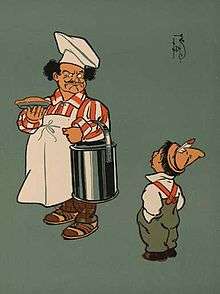Simple Simon (nursery rhyme)
This article is about the nursery rhyme. For other uses, see Simple Simon (disambiguation).
| "Simple Simon" | |
|---|---|
| Roud #19777 | |
 William Wallace Denslow's illustrations for Simple Simon, from a 1901 edition of Mother Goose | |
| Song | |
| Written | England |
| Published | 1764 |
| Form | Nursery rhyme |
| Writer(s) | Traditional |
| Language | English |
"Simple Simon" is a popular English language nursery rhyme. It has a Roud Folk Song Index number of 19777.
Lyrics
The rhyme is as follows;
- Simple Simon met a pieman,
- Going to the fair;
- Says Simple Simon to the pieman,
- Let me taste your ware.
- Says the pieman to Simple Simon,
- Show me first your penny;
- Says Simple Simon to the pieman,
- Indeed I have not any.
- Simple Simon went a-fishing,
- For to catch a whale;
- All the water he had got,
- Was in his mother's pail.
- Simple Simon went to look
- If plums grew on a thistle;
- He pricked his fingers very much,
- Which made poor Simon whistle.[1]
Origins

Simple Simon and the pie man, according to Denslow
The verses used today are the first of a longer chapbook history first published in 1764.[1] The character of Simple Simon may have been in circulation much longer, possibly appearing in an Elizabethan chapbook and in a ballad, Simple Simon's Misfortunes and his Wife Margery's Cruelty, from about 1685.[1] Another possible inspiration was Simon Edy, a beggar in the St Giles area in the 18th century.[2]
In popular culture
- Laurel and Hardy "played", respectively, Simple Simon and the pieman in Walt Disney's animated short, Mother Goose Goes Hollywood.
- Simple Simon also appeared in the 1933 Disney cartoon Old King Cole.
- Simple Simon was played by Charley Rogers in Babes in Toyland (1934 film).
- Animation studio Comicolor produced an animated short based on the rhyme in 1935 titled Simple Simon. The short focuses mostly on an expanded version of Simon's encounter with the Pie Man and his visit to the fair, and also adds a pet goose to the cast. The short was produced by animator Ub Iwerks.
- In the 1936 Merrie Melodies cartoon I Love to Singa, during the amateur hour segment, the country bumpkin bird (voiced by Joe Dougherty, who was the original voice of Porky Pig) stuttered through the first and almost all of the second verse of Simple Simon before rejecting himself.
- The Three Stooges did a variant version, which began the usual way, and ended:
- Said the pieman to Simple Simon,
- "Show me first your penny."
- Said Simple Simon to the pieman,
- "Scram! Ya don't get any!"
- (And a pie in the face)
- Another variant of the nursery rhyme was an animated film on Sesame Street.
- In the film "Die Hard with a Vengeance" (1995), the film's antagonist, Simon Peter Gruber (Jeremy Irons), reads the beginning of the poem to John McClane's (Bruce Willis) boss, Inspector Walter Cobb (Larry Bryggman).
- In a Bullwinkle's Corner segment of the Rocky and Bullwinkle Show, while performing Simple Simon, Bullwinkle and Boris Badenov change into a version of Abbott and Costello's Who's on First sketch.
- An image of Simple Simon is discussed in Stephen King's novel Needful Things.
- Simple Simon is mentioned as a character in the video game The Wolf Among Us.
- The poem is referenced in The Simpsons episode "Simple Simpson" which features Homer Simpson disguising himself as a superhero called "the Pie Man."
- The 2010 film Simple Simon borrows from a similar premise.
- In 2013, Polaris produced an internet series called "Simple Simon". The show featured Simon Lane and Lewis Brindley of "The Yogscast", and the show revolved around Simon having to correctly answer questions about a guest. The show referenced the nursery rhyme further by ending each episode With the question of what the guests favorite type of pie is.
Notes
- 1 2 3 I. Opie and P. Opie, The Oxford Dictionary of Nursery Rhymes (Oxford University Press, 1951, 2nd edn., 1997), pp. 333-4.
- ↑ Walter Thornbury, Edward Walford (1880), Old and New London: Westminster and the western suburbs Volume 3 of Old and New London: A Narrative of Its History, Its People, and Its Places, Old and New London, Cassell, Petter, & Galpin, p. 207
External links
This article is issued from Wikipedia - version of the 11/7/2016. The text is available under the Creative Commons Attribution/Share Alike but additional terms may apply for the media files.